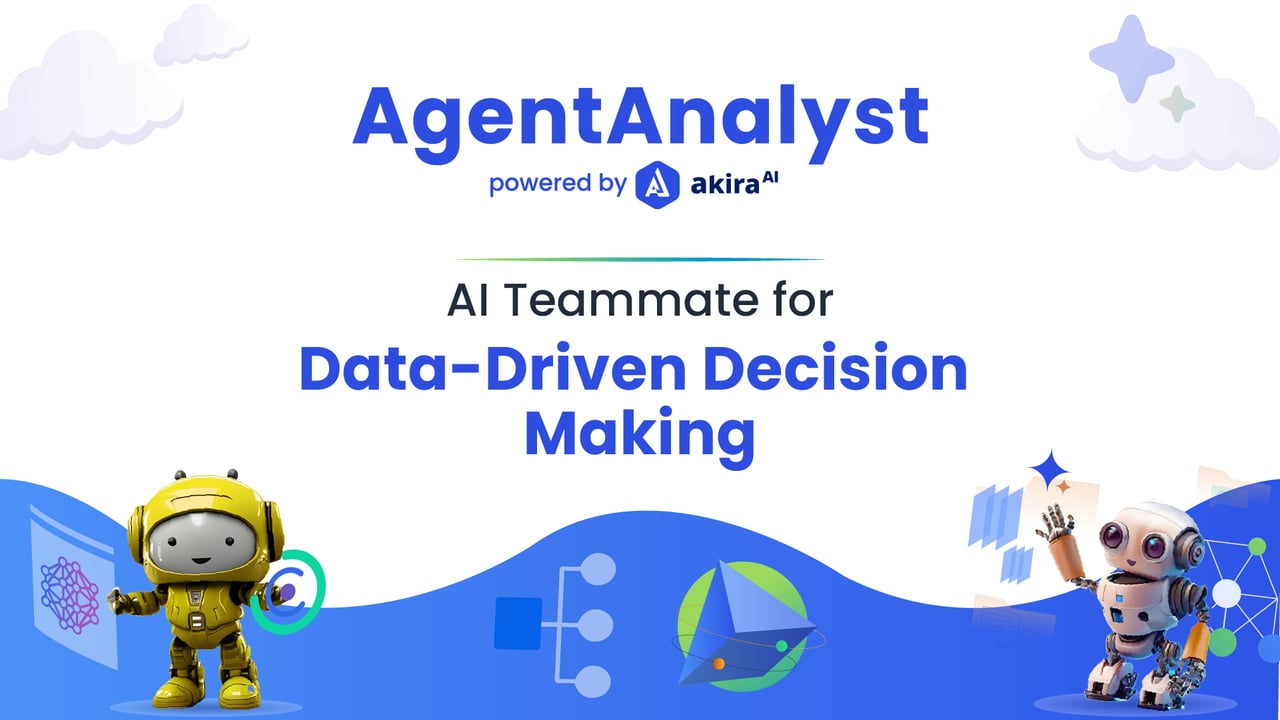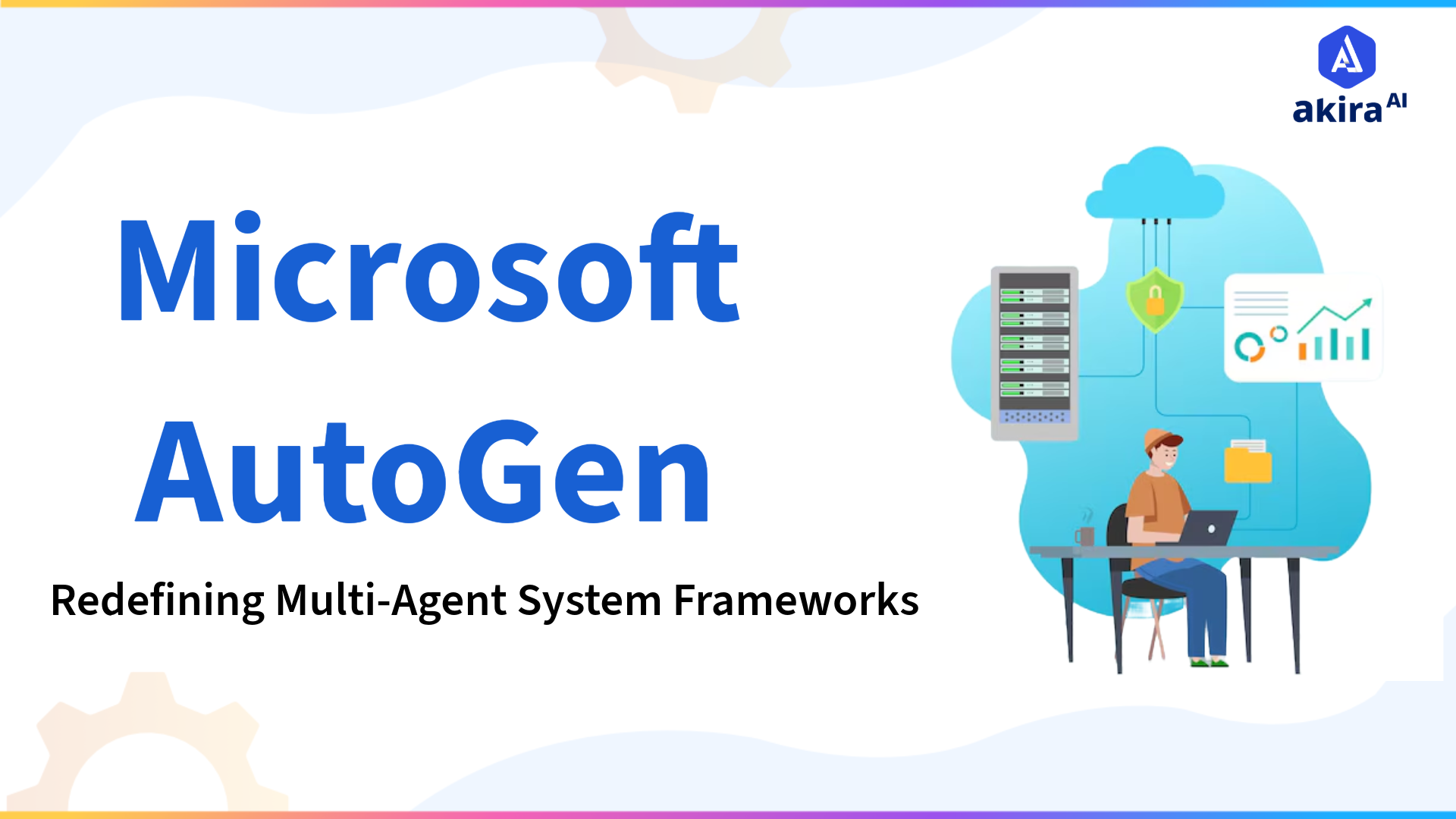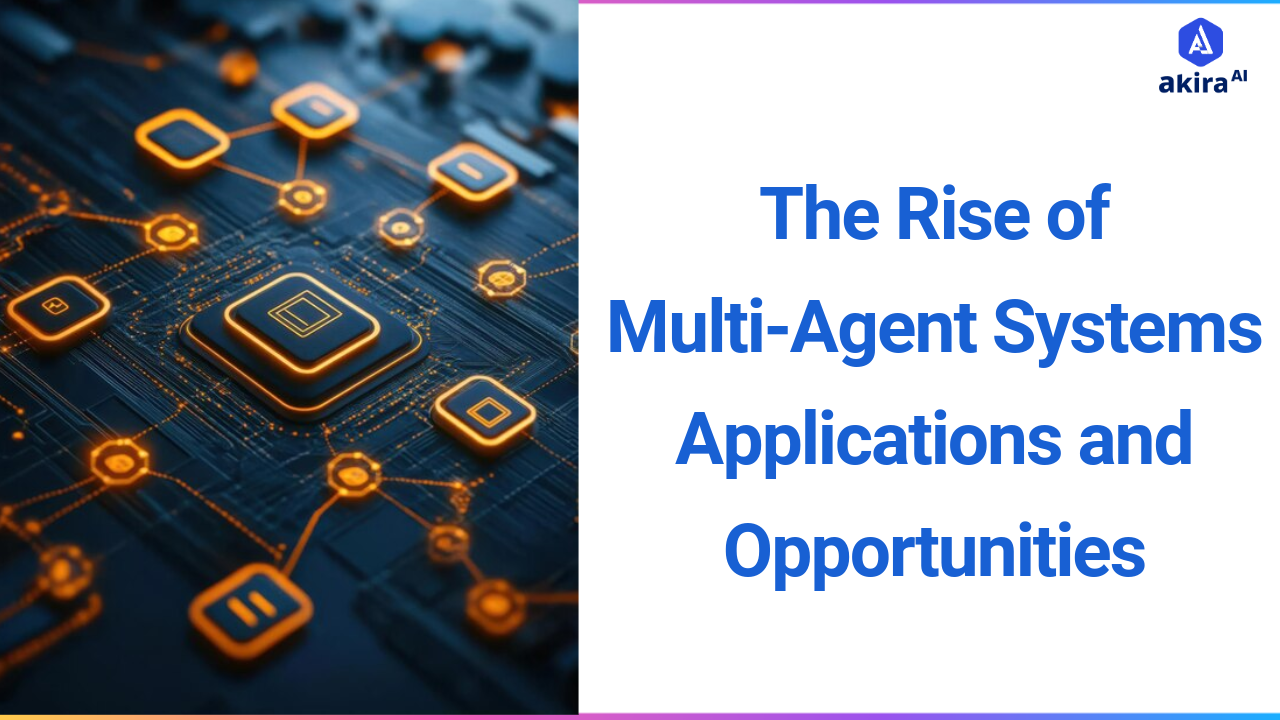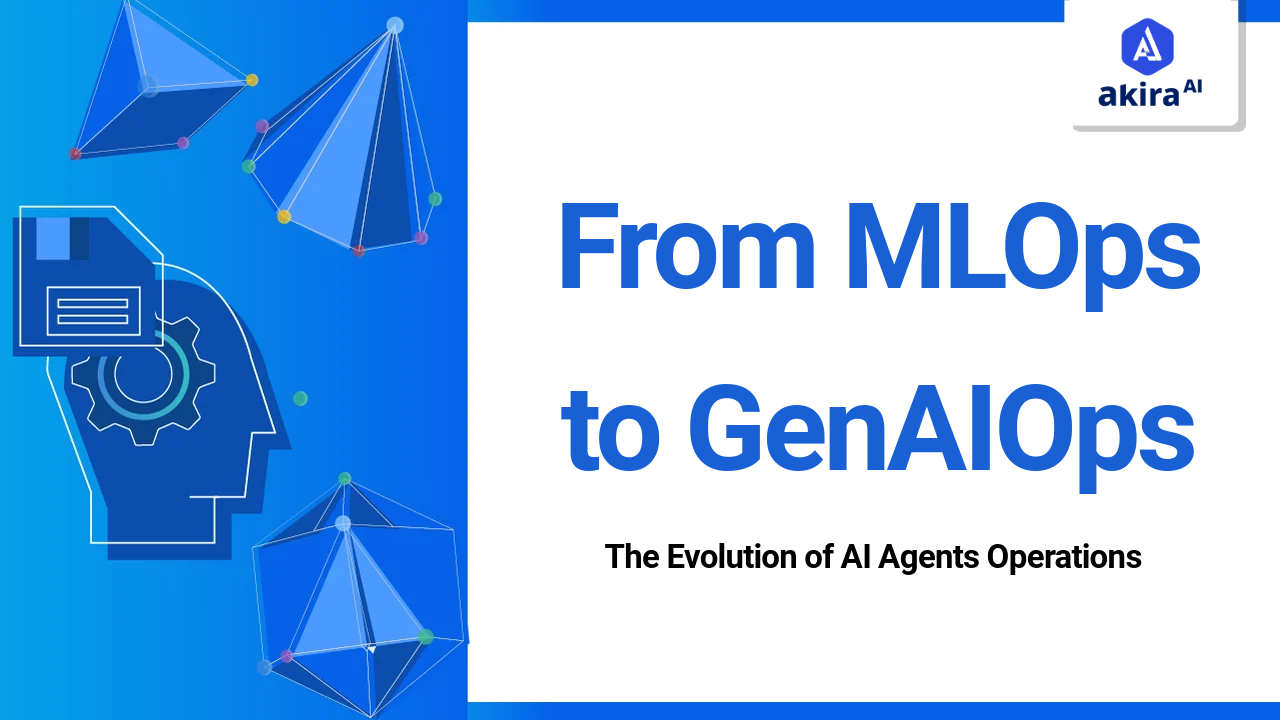Key Insights
-
Seamless Real-Time Insights: AgentAnalyst integrates diverse data sources to deliver actionable insights in real-time, ensuring informed decision-making.
-
Empowered Accessibility: By leveraging natural language processing, non-technical users can perform complex analyses effortlessly.
-
Scalable for Growth: Its robust architecture adapts to growing data volumes, ensuring consistent value as businesses expand.

In today’s business landscape, data has become a key driver of strategic decision-making, helping enterprises navigate market dynamics, optimize operations, and foster innovation. Once a passive outcome of transactions, data is now central to business success, enabling organizations to gain a competitive edge, enhance customer relationships, and streamline operations across industries like finance and healthcare.
This began the next wave of AI—agentic, multi-agent systems that work harmoniously toward automated data analytics and decision-making. The agentic workflow embedded helps automate data analysis tasks that are high-value and complex for business in efficiency with real-time delivery of insights for quicker and better decisions.
This blog will delve into the technical aspects of this framework, exploring how it works, the technologies that power it, and the benefits it offers to financial institutions and their customers.
Key Challenges of Traditional Data Fragementation
-
Fragmentation of Data Sources: Business organizations work with data scattered across multiple departments, systems, and geographic locations, leading to unstructured data collection, storage, and analysis practices. Such fragmentation impedes the process of maintaining a single and holistic view of the business.
-
Technical Complexity: Traditional data analysis tools require specialized knowledge and technical expertise, creating a barrier for non-technical users. This complexity can slow down the process of deriving valuable insights, leading to inefficiencies in decision-making.
-
Slow Insight Generation: Manual data processing and outdated analytical methodologies delay the delivery of actionable insights. In fast-paced business environments, these delays reduce agility and responsiveness, impacting the ability to make timely strategic decisions.
-
Inconsistent Data Quality: With data originating from diverse and often unstructured sources, ensuring consistent data quality remains a challenge. Poor data quality can result in inaccurate or misleading insights, which can adversely affect business outcomes.
-
Resource Constraints: Data analysis often demands significant time and human resources, diverting valuable personnel from higher-level strategic tasks. The reliance on skilled professionals further limits the scalability of traditional data analysis methods.
-
Inability to Scale: As organizations grow, the volume of data increases exponentially. Traditional methods struggle to scale efficiently, making it difficult for businesses to keep up with data demands and stay competitive in a rapidly evolving market.
To overcome these hurdles, AgentAnalyst AI teammate steps in to revolutionize the data analysis process. These teammates integrate disparate data sources, automate complex analytical tasks, and accelerate the time to actionable insights. Leveraging cutting-edge AI algorithms not only simplifies data processing but also ensures that insights are generated in real time, enabling organizations to stay ahead in their decision-making processes. This transformative tool enables businesses to extract more value from their data, empowering them to make smarter, faster, and more informed decisions.
What is AgentAnalyst?
AgentAnalyst is a multiagent system powered by LLMs and designed to address the complexities of data analysis, making it more accessible and efficient for businesses. By leveraging cutting-edge technology, AgentAnalyst simplifies the data analysis process and empowers enterprises to derive actionable insights quickly and effectively. AgentAnalyst is an AI-powered data analysis tool designed to instantly transform raw data into actionable insights. It empowers teams to make informed, real-time decisions using Natural Language, bridging the gap between complex data analysis and everyday business operations.
How AgentAnalyst Solves Key Challenges?
-
Quick Start with Any Data: AgentAnalyst enables users to initiate data analysis swiftly, regardless of database size or complexity. Its streamlined setup allows businesses to leverage data without delays. The intuitive interface ensures both technical and non-technical users can easily navigate the platform and quickly extract insights.
-
Turn Data into Strategy with Natural Language: Agent Analyst’s advanced NLP capabilities allow users to query data in plain English, making it accessible to non-technical staff. The platform translates complex data into actionable insights, enabling businesses to make strategic decisions faster.
-
Real-Time Decision Making: With real-time data analysis, AgentAnalyst provides instant insights, helping businesses respond to changing conditions quickly. Continuous monitoring ensures users are alerted to key trends or changes in data for timely decision-making.
-
Transform Business Experts into Analytics Leaders: By simplifying data analysis, AgentAnalyst empowers business professionals to take the lead in data-driven decision-making. Its collaborative environment bridges the gap between technical and business teams, driving better outcomes across the organization.
How AgentAnalyst Works?
AgentAnalyst is fully integrated with various user databases in the cloud or on-premises. With native connectors and APIs present to process structured and unstructured data sources including Postgres, Snowflake, Athena, and MongoDB, this platform seamlessly integrates with your choice. Such a complex creation of these connections is achieved through the Master Orchestrator Agent which consists of LLM and a Knowledge Graph.

Step 1: Connect to Data sources
One of the high points of the AgentAnalyst is handling simple and complex queries through NLP. The Data Analysis Agent is at the very core in this regard:
-
Natural Language Queries: The system allows users to interact with it in their spoken language.
-
Agent Workflow: The agent gets its information based on the user's query. The outcome of the query can be directly visualized or, depending on the case, piped through more complex analysis agents.
.png?width=3840&height=2160&name=Playground%20Open2%20(1).png)
Step 2: Querying Data and Generating Insights
Beyond basic querying, AgentAnalyst truly excels in executing advanced analytics with its Data Analysis Agent, Anomaly Detection Agent, and visualization agent for deeper insights into descriptive analysis and visualization.
Step 3: Advanced Analytical Dashboard
Architecture Diagram of AgentAnalyst
AgentAnalyst is built on a multi-agent framework involving multiple agents coordinating to produce a meaningful result orchestrated by a master agent. 
Fig 4: Technical Architecture of AgentAnalyst
AgentAnalyst is more than a simple data analysis tool. It is backed by an advanced multi-agent system that fundamentally changes how users interact with their data. The agent analyst makes use of a network of specialized AI agents that are individually capable of performing tasks and can harmoniously work towards achieving the derivation of rich insights from data.
1. Data Sources
The AgentAnalyst connects to multiple data sources ranging from traditional to cloud-based databases hosting structured and unstructured data.
-
Postgres: An older, mature relational database platform widely used within large enterprise transactional data processing.
-
Snowflake: Big data and cloud data warehousing for analytics workloads
-
Athena: Athena from AWS is a query analytics service for S3 storage. It can be used to perform analytics on big data in the cloud using SQL.
2. Master Orchestrator
It acts as a central control agent for interactions between various agents along the data life cycle. It also handles and orchestrates the incoming data flow from the data sources and delegates them to the data transformation agent for preprocessing. It then orchestrates the flow between all the agents to complete the defined goal.
3. Data Preprocessing Agent
The Data Processing Agent wraps data ingestion, pre-processing, and transformation into one neat workflow. It helps maintain consistency for data in these different formats of data sets. It then cleans and preprocesses the data with several correctness checks, handling missing values before the transformation.
4. Data Analysis Agent
The Data Analysis Agent does the core analytical operations. The agent will comprise both descriptive and predictive analytics. It helps derive critical insights from the data supporting the day-to-day business intelligence activities, including advanced analytics such as "What if" and cohort analyses.
5. Anomaly Detection Agent
The Anomaly Detection Agent identifies outliers in the data, such as when a trend unusually deviates or when fraud exists in the data. The agent uses sophisticated machine learning algorithms to automatically recommend the best action based on findings associated with the trends in resources.
6. RAG Agent (Retrieval-Augmented-Generation)
The RAG Agent answers the questions instantaneously by handling the high-frequency, low-complexity queries and freeing higher-order agents to perform complex analytics.
7. Visualization Agent
This agent automates the creation of personalized visual reports and dashboards based on the insights coming out of the data. It transforms raw data into intuitive graphical formats, including graphs, charts, and heat maps.
8. Final processing
-
Data Insights: Insights derived from the Data Analysis Agent are provided to the user for decision-making.
-
Insights: AI-driven predictions and business recommendations generated by the AI Insights Agent.
-
Simple Query Results: Quick answers to user queries processed by the RAG Agent
-
Custom Visuals: Visual reports generated by the Visualization Agent that help users understand the data and the insights it provides.
Technological Stack in AgentAnalyst
Our composite AI framework utilizes the components from traditional Machine learning to advance Multi-agent systems:
-
Multi-Agent Layer: Akira AI leverages advanced agent frameworks like LangChain, AutoGen, and Langraph to create intelligent multi-functional AI agents. These agents collaborate seamlessly to execute complex tasks such as data analysis, decision-making, and workflow automation.
This layer also includes a Master Orchestrator Agent, which utilizes Large Language Models (LLMs) and Knowledge Graphs to coordinate inter-agent communication and manage operations efficiently. -
Data Layer: Akira AI’s data architecture is built for robustness and efficiency. It employs Qdrant for vector data storage, ensuring fast and accurate retrieval of embeddings. ETL (Extract, Transform, Load) processes are managed using industry-leading tools like Apache Airflow, AWS Glue, and Google Dataflow, which enable streamlined data ingestion, processing, and transformation across diverse sources.
-
Backend: The backend is designed to support scalability and security. Akira AI’s API pipelines are crafted following industry best practices, ensuring that applications are reliable, responsive, and capable of handling large volumes of data without compromising security.
-
Frontend: The user interface (UI) is built with a focus on usability and security. It offers a clean, intuitive design, ensuring users can easily interact with the system. Robust security measures are integrated into the UI to safeguard user data and provide a seamless experience.
-
Infrastructure: Akira AI’s infrastructure supports diverse deployment options, including on-premises, cloud-based, and hybrid models. This flexibility ensures organizations can choose an approach that aligns with their operational requirements, budget, and data security preferences, making Akira AI adaptable to a wide range of environments.
Integration with Existing Data Systems
One of the standout features of AgentAnalyst is its ability to integrate seamlessly with a wide array of industry-standard platforms, ensuring that the data analysis workflows remain smooth and uninterrupted. AgentAnalyst also supports the development of APIs and data connectors for application-specific integrations, aside from support for standard integrations. These custom connectors enable seamless data flow into the system for analysis, for example:
-
Databricks: Easily integrates with Databricks for big data and machine learning. Fetch insights from the setup by pulling data from Databricks on your data querying and analysis.
-
AWS S3: Allows querying with structured and unstructured data in an S3 bucket —one of the most preferred cloud storage—making querying large datasets from the cloud easy.
-
SAP: Connects to SAP modules for current data operational analysis in real time.
-
Snowflake: Connects to the Snowflake Data Warehouse, whereby large-scale datasets can easily be queried and analyzed through the power of Snowflakes' storage and computing.
-
Big Query: Large-scale data within the Google Cloud environment can be analyzed easily.
Use Cases of AgentAnalyst
Agent Analyst’s AI-powered data analysis capabilities can transform how industries leverage their data, offering tailored solutions that drive efficiency, accuracy, and strategic insights.
Enterprises
-
Historical Sales Data Analysis: Review past sales performance and identify trends to improve forecasting accuracy.
-
Customer Data Analysis: Segment customers based on behaviour and demographics to create targeted marketing strategies.
-
Workforce Data Evaluation: Assess employee performance metrics to enhance talent management and optimize productivity.
Finance
-
Transaction Data Analysis: Monitor and analyze transaction data to detect and prevent fraud.
-
Credit Score Analysis: Evaluate customer credit histories to make informed lending decisions.
-
Financial Report Analysis: Quickly analyze financial statements to assess profitability and financial health.
Manufacturing
- Production Data Analysis: Monitor production data to optimize manufacturing processes and reduce waste.
- Inventory Data Analysis: Analyze inventory levels to prevent stockouts and manage supplies efficiently.
- Supply Chain Data Analysis: Review supply chain data to improve logistics and vendor management.
Supply Chain
- Demand Forecasting Analysis: Use historical sales data to predict future demand and optimize inventory levels.
- Logistics Data Analysis: Analyze delivery and transportation data to improve route planning and reduce costs.
- Supplier Data Analysis: Evaluate supplier performance to ensure reliable and timely deliveries.
Healthcare
-
Patient Data Analysis: Review patient histories to identify trends and improve treatment plans.
-
Medical Records Analysis: Analyze medical records for better clinical decision-making and patient care.
-
Operational Data Analysis: Optimize hospital operations by analyzing patient flow and resource allocation data.
Benefits of Using AgentAnalyst
-
Enhanced Data Accessibility: Users can interact with data using natural language, eliminating the need for specialized technical knowledge. This democratizes data access, allowing all employees to perform complex data analysis effortlessly. The platform's user-friendly design ensures users can easily navigate and utilize its features, reducing the learning curve.
-
Comprehensive Data Integration: Integrate data from various sources, such as databases, spreadsheets, and third-party applications, into a single, cohesive platform. This holistic view enables more accurate and comprehensive analysis. Agent Analyst supports seamless connectivity with numerous data sources, ensuring all relevant data is available for analysis without manual data consolidation.
-
Real-Time Insights: Access up-to-the-minute data, allowing businesses to respond swiftly to emerging trends and changes in the market. This capability is crucial for maintaining a competitive edge. Automated alerts for specific data thresholds or events ensure critical information is promptly delivered to decision-makers.
-
Predictive Analytics: Leverage advanced predictive models to forecast future trends and outcomes, aiding in proactive decision-making and strategic planning. Perform scenario analysis to evaluate potential outcomes of different business strategies, helping to identify the most beneficial course of action.



